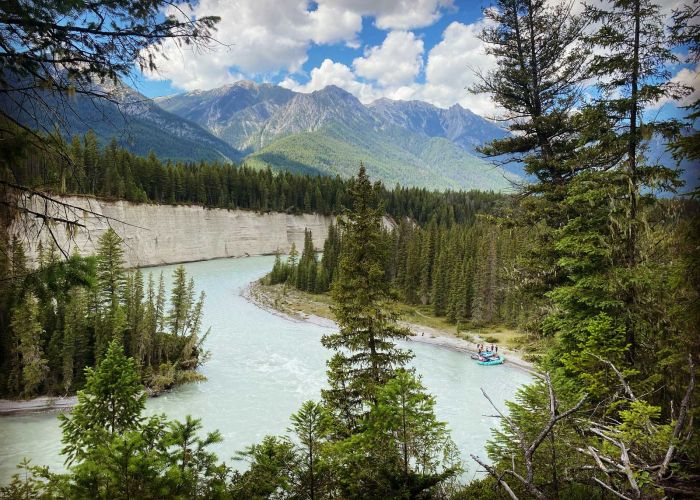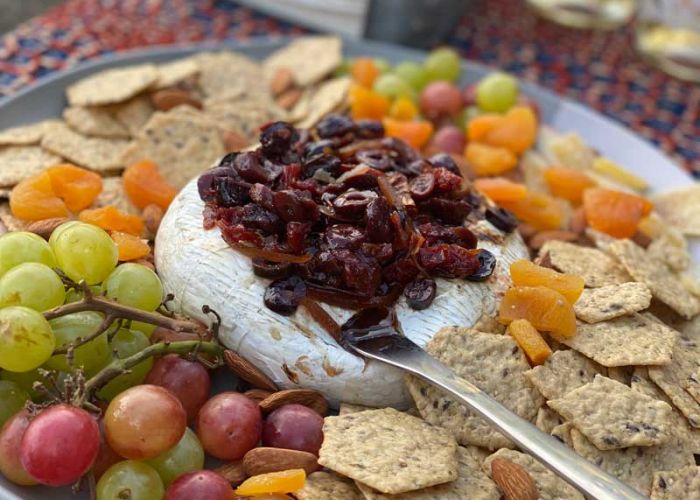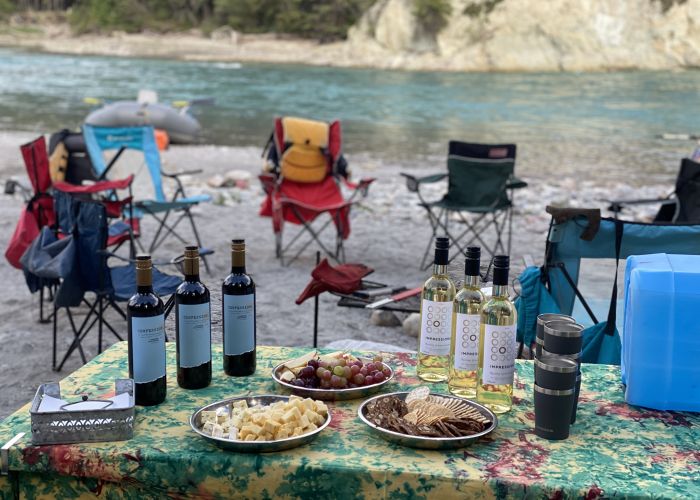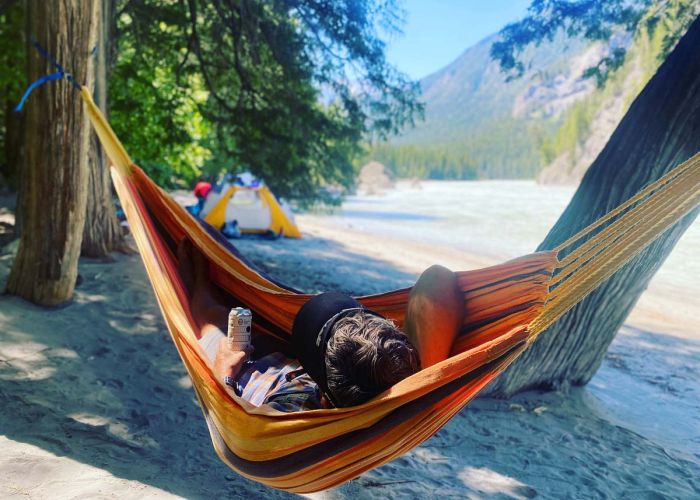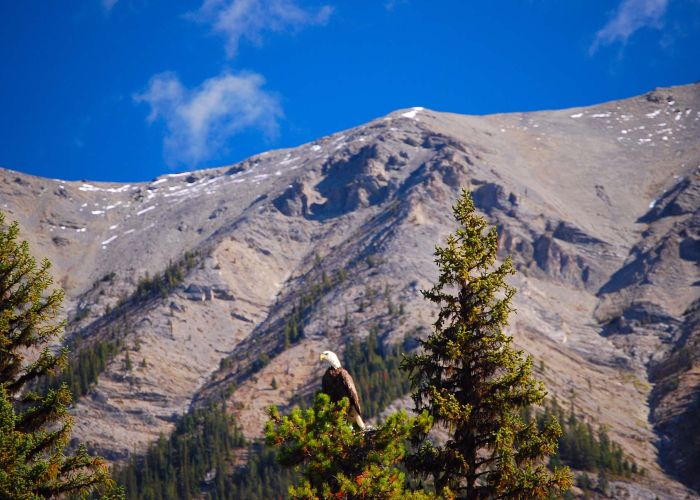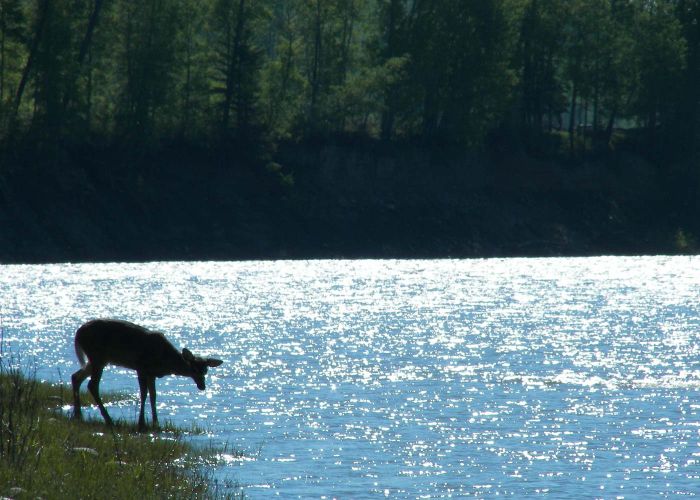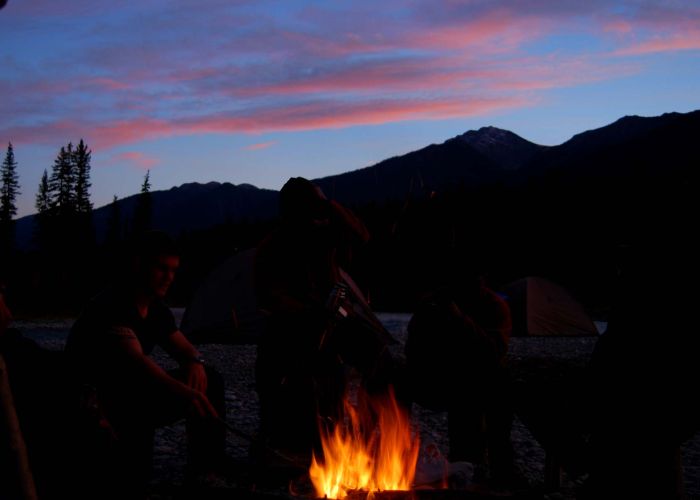Kootenay River Multi-Day Raft Trip
Highlights
- Scenic drive through Banff and Kootenay National Parks
- British Columbia rafting in the Canadian Rockies
- A chance to see wildlife such as deer, moose, bighorn sheep and eagles
- Float past amazing riverside waterfalls and hoodoos
- Spectacular company, great food and top of the line gear
- Fun and friendly class II - III white water
The Kootenay River is a “must do” Canadian classic for any river tripping enthusiast or those new to rafting and camping. Situated in the rugged Canadian Rockies, the Kootenay is full of fast water, fun rapids and epic scenery. We offer 3 or 4 day trips on the river, and during that time guests will experience a beautiful float passing waterfalls poaring into the river, deep canyons, hoodoos, open valleys and epic riverside campsites!
Stroll along the river, hike to one of the many waterfalls, play games, read a book or just relax by the fire while our guides get camp set, the brew on and dinner ready. It’s a vacation, so enjoy it.
We are booking now for the summer of 2025, and are offering you an experience of a lifetime. So come join us, you wont regret it!
Life on the River
The Kootenay Valley is a fantastic area for viewing wildlife. Wildlife sightings have included grizzly and black bear, moose, cougar, bighorn sheep, elk, deer, mountain goat and wolf. Indigenous species also include coyote, lynx, marten and red fox. In the fall eagles may be found feeding on the salmon and occasionally can also be seen soaring over the canyons of the middle and lower sections of our trip. A large variety of water fowl and song birds also call this river valley home. Canada geese and the fish-eating merganser are found along the river.
The mountain slopes and forested valleys are home to a variety of trees including pine, fir, spruce and cedar. Aspen, poplar, and cottonwood are found on the alluvial fans and river terraces, while wildflowers such as fireweed, yellow cinquefoil, hare bells, red paint brush and wood lilly's cover the river’s edge.
At the end of each day on the water, we will head to shore to set camp for the night. On land, our first task is to unload the rafts. Guests can grab their Billy Bags and locate an area on the beach or tree line to camp for the night. Once tents are set-up and everyone is settled in, guests will have the option to relax while the rest of the guides set up the kitchen and fire/seating area.
As dinner is being prepared our chef, will lay out a few cheese and meat platters by the fire for guests to pick away at.
In the morning coffee, tea, hot chocolate and some juice and water will be ready along with fresh fruit and cereal will be ready in the kitchen area. You can fill your mug and/or grab a bite, then head off and pack up your gear while breakfast is being prepared. Once breakfast is served and devoured, camp will be broken down and loaded onto the rafts.
2025 Dates & Prices
2021 Dates & Prices
Available Dates 2026
- June 19 - 21 SUMMER SOLTICE (3 DAY)
- July 3 - 5 (3 DAY)
- July 17 - 19 - WOMEN ONLY (3 DAY)
- July 24 - 26 - ADULTS ONLY (3 DAY)
- Aug 7 - 10 - LONG TABLE DINNER & MUSICAL GUESTS (4 DAY)
- Aug 15 - 18 (4 DAY)
Trip Prices
- 3 Day - Adult: $999 CAD + GST
- 3 Day - Youth: $899 CAD + GST
- 4 Day - Adult: $1,299 CAD + GST
- 4 Day - Youth: $1,199 CAD + GST
Don't see a date that fits your schedule? Call and ask about our private group options! Price does not include gratuities
- Meeting Place: Put-in at Kootenay River Day Use, B.C Canada
- Meeting Time: 9:30 AM the morning of your trip
- Return Time to Vehicles: Approximately 3:30 PM on day 3
- River Rating: Class II-III
- River Distance Kms: 100
- Put-In: Highway 93 South, B.C., Canada
- Take - Out: Canal Flats, B.C., Canada
- Age Restrictions: Minimum age is 5
- Boat Type/Propulsion: Oar raft, paddle assisted
- Trip Duration: 3 days, 2 nights or 4 days, 3nights
- Minimum occupancy: 6 Max occupancy: 14
- Transportation: Guest will meet morning of trip at the launch location along 93 south.
- Skilled, professional guide service
- All meals from lunch on day 1 through lunch on last day
- 2-3 nights catered camping
- 1 waterproof bag to hold your gear for the trip (approximate sealed size: 33” tall x 16″ diameter—with a maximum capacity of 110 liters).
- 1 small waterproof bag for camera and other small items you’ll want during the day (approximate sealed size: 17” tall x 9” diameter)
- 2-person tent on a shared basis, sleeping bag and sleeping pad
- PFD: Personal Floatation Device to be worn at all time in the raft
- River Booties open request
- Camp amenities such as chairs, eating utensils, cups and plates
- High quality inflatable rafts and related equipment
- Van transfer from Canal Flats back to the put-in.
- Transportation to and from Canmore pre/post actual trip dates
- Pre- and post-trip accommodations and meals
- Insurance of any kind including travel and cancellation insurances
- Fishing gear and license (optional)
- Items of a personal nature and equipment (an equipment list will be provided)
- Gratuities- cash tip for guides of 10% -15% of total trip cost is customary on over night tours. This reflects the amount of work, prep, service and care guides provide on a tour of this type.
- Park Pass for your vehicle (we will supply a parking pass for your vehicle at the Put-in location at the river the morning of your trip).
Searching Availability...
Searching Availability...
PACKING FOR YOUR TRIP
All clothing (with a few exceptions) should be quick-drying and made of merino wool or synthetics. Warmth and comfort are the main objectives with this outline. Weather conditions can vary considerably in the mountains no matter the season. It’s important to dress to the weather of the day. By following the packing guidelines provided, you should be prepared for all weather and environmental conditions.
View the Packing ListClothing
Raftwear Always start with sunscreen no matter if it's sunny or cloudy, base layers, pants/shorts that can get wet and a long-sleeved shirt/warm hoody and of course a river hat. Additional layers of fleece, socks and rain gear can be stored in your day bag. As the day warms up, layers can be taken off and stored away. Rain pants should be large enough to accommodate base layers.
In Camp Cotton pants/shorts and shirts make great camp wear. A dry set of long underwear is the perfect base layer under long pants and a fleece sweater when first off the river or if the temperatures are on the cool side.
Hiking Clothes Choose lightweight fabrics that breathe well while walking. Base layers can be added or removed based on the weather. Whatever you choose, make sure you have comfortable freedom of movement, especially for uphill and downhill walking.
Footwear
Rafter Comfortable runners/shoes/sandals that you don't mind getting wet and warm wool/fleece/neoprene socks. At times an neoprene shoe with good soles may be appropriate. Sandals will not provide the protection you want from the water by themselves when its cold. Your feet will get wet getting in and out of the boat and the water is cold. No-slip soles are ideal.
In camp Comfy shoes/light hikers/flip flops or sandals make for good camp shoes. It’s nice to put on dry socks and shoes after a day on the water. Flip flops or slip-on sandals are OK for wearing in camp only.
Hiking We do have an optional small hike or two so having decent hikers/sturdy shoes are important. Our trails are often rooty or sometimes muddy, you need a good strolling shoe or boot with a firm sole, a degree of water resistance and some ankle support. It’s easy to find a “hybrid” walking boot, which combines the lightweight, ventilated features of a shoe with the support and durability of a boot.
Socks We recommend wool socks, as they will keep your feet warm if they get wet. It’s a good idea to change into clean, dry socks once you’re off the river at camp.
If you plan to buy footwear for the trip, allow time for break-in and wear your footwear until its comfy.
Headwear
Bring along a good river hat with a big brim to help shade the sun on those hot sunny days. If the weather gets cool, having a beanie or toque will be much appreciated.
To Avoid Being Cold
Merino wool or synthetic long underwear is a must-have on river trips. It keeps you warm even if it’s wet, dries quickly and can be layered under your rain jacket and pants. Be aware that cotton items, once wet, do not insulate; only synthetic and wool materials will keep you warm if wet.
Pile or Fleece
This fabric is warm, dries quickly and is not excessively bulky. It can be found in many different styles and colors. Bring along good fleece tops and bottoms, along with a warm hat and gloves. You’ll want to double-up on your synthetic layers so that you’ll have a set to wear in the boat and a set of warm, dry clothes for camp.
Raingear
It is one of the essential items that all passengers should have, no matter what time of year you are traveling. You will want a waterproof rain jacket and pants for on the water and in camp on those wet days. Look for jacket and pants that are 100% waterproof, not just water resistant. A hooded jacket is recommended, with secure closures for your head, neck and wrists. Pants should be large enough to accommodate several base layers underneath.
Sun Protection
Protecting yourself from the sun should be taken very seriously. A hat, sunscreen, lip balm and sunglasses are a must. In many cases, a long-sleeve shirt is the best method for preventing sunburn on your upper body. Light-weight long pants may also be appropriate to protect your legs. Consider bringing a good hat that offers full coverage, such as a wide-brimmed hat.
Bugs & Mosquitoes
Bugs and mosquitoes vary depending on location and time of year. It’s a good idea to come prepared with insect repellent. Long sleeved shirts and pants may be desirable at times.
Packing Your Gear
At the pre-trip meeting each person will be given a large waterproof "Billy Bag" (110 Ltr).This bag will be for your clothing and personal items and will be your “checked luggage” and accessible in camp. Tents and sleep kits are stowed separately. We also provide a small waterproof bag for day use where you can keep items such as raingear, camera, sunscreen, lip balm, etc. (approximate sealed size: 17” tall x 9” diameter). The bags are cylindrical in shape and pack from the top. At the end of the river trip, you will return to Canmore with your waterproof bag, where you will be able to unpack your gear before your trip home.
Extra Luggage
We recommend you take on the river only what’s absolutely necessary. Keeping gear to a minimum ensures it will fit into the waterproof bags we supply and reduces unnecessary packing and unpacking in camp. If you have extra items needing storage, you may be able to store it at your hotel or campsite back in Canmore or Banff
Kootenay River Packing List
The following is a list of items that you are responsible to bring along for the trip. Maximum baggage allowed per person. These items must be kept in separate bags; the small kitchen bag will be stored with the group kitchen/food overnight. If you are coming as a group or couple, try to maximize space to cut down on the number of bags. We have a limited amount of room in the rafts, so please respect the baggage restrictions.
View Packing Tips Download This List (PDF)- ☐ Daypack: for day hikes. It should be large enough to carry raingear, jacket, camera and water bottle
- ☐ Two 1-liter water bottles: durable and reusable if you have one; an empty soft drink bottle works fine if you don’t
- ☐ Headlamp or flashlight (consider bringing extra batteries)
- ☐ Sunglasses (preferable polarized) with securing strap (consider bringing a spare)
- ☐ Small, quick-drying towel and washcloth
- ☐ Bathing towels/wipes: pre-moistened disposable wipes such as Coleman Swash Cloths
- ☐ Toiletries including biodegradable soap
- ☐ Sunscreen and lip protection: waterproof & SPF 30 or higher (aerosol sprays not recommended)
- ☐ Moisturizing lotion or cream
- ☐ Insect repellent
- ☐ Personal first aid kit (Band-aids, antibiotic ointment, ibuprofen, moleskin, eye drops, etc.)
- ☐ Spare pair of glasses and/or contacts
- ☐ Cash for gratuities and incidentals
- Footwear:
- ☐ Lightweight hiking boots or shoes: 1 pair, comfortable and with good tread for hiking and in camp
- ☐ Sandals with a heel strap or flip flops
- ☐ Socks: 2 pair, wool or fleece socks
- Clothing:
- ☐ Long-sleeved shirt: 1 quick drying (UPF rated shirts are great)
- ☐ Long pants: 1 lightweight and quick-drying
- ☐ Shade hat or visor with securing strap
- ☐ Rain jacket & pants: waterproof (not water resistant). A hooded jacket with secure closures is recommended
- ☐ Swimsuit / trunks
- ☐ Underwear
- ☐ Shorts: 1-2 pair
- ☐ T-shirts/tops: 2
- ☐ Base layers/long underwear—tops & bottoms, light to mid-weight merino wool or synthetic
- ☐ Fleece pants: (medium to expedition weight)
- ☐ Down or synthetic insulated jacket for camp wear
- ☐ Beanie-style hat and gloves—wool or fleece are ideal
- Optional Items:
- ☐ Binoculars: small
- ☐ Camera and accessories
- ☐ Plastic bags: Large trash bags and assorted zip-lock bags to separate wet or dirty clothes
- ☐ Sketchbook, notebook and pen, paperback book
- ☐ Fishing rod with case and tackle (fishing license is required)
- ☐ Bandana
- ☐ Whiskbroom: small (no long handle) to sweep wet sand off tent



